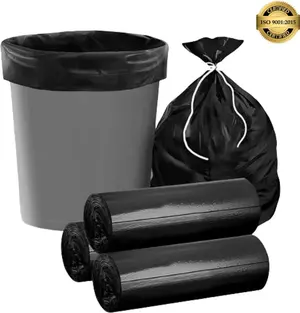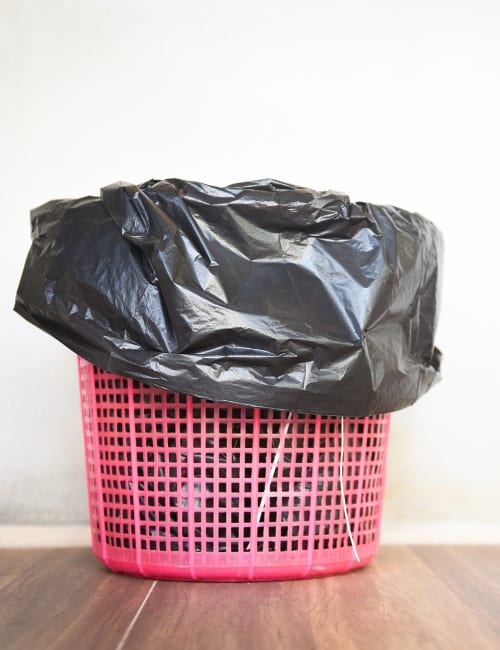Decoding Trash Bags: From Trash to Treasure
In this article, we explore the subtle distinction (or lack thereof) between "garbage bags" and "trash bags." While the terminology may vary by region, both serve the same purpose: collecting and containing waste. Most trash bags are indeed made of plastic, typically from Low-Density Polyethylene (LDPE) or High-Density Polyethylene (HDPE). However, you can also use smaller plastic bags for light waste, with care taken to avoid sharp or heavy items. Understanding these nuances will help you make the right choice for your waste disposal needs.
Exploring the Distinction Between Trash Bags and Garbage Bags.

Trash bags are an essential and often overlooked part of our daily lives. They play a crucial role in maintaining cleanliness, hygiene, and organization in our homes and workplaces. Despite their simplicity, there is much more to trash bags than meets the eye.
Types of Trash Bags
- Kitchen Trash Bags: Kitchen trash bags are typically smaller and are designed to hold household waste, including food scraps, packaging, and other general kitchen refuse. They come in various sizes, typically ranging from 4 gallons to 13 gallons, and are usually scented to help control odors.
- Tall Kitchen Trash Bags: These are slightly larger than standard kitchen trash bags, usually around 13 gallons in size. They are commonly used in larger kitchen trash cans and can accommodate more waste.
- Lawn and Leaf Bags: These bags are designed for yard work and outdoor clean-up. They are usually larger in size, made from heavy-duty materials to handle leaves, branches, and other yard debris.
- Contractor Trash Bags: These are heavy-duty, rugged bags designed for construction and renovation projects. They can withstand sharp or heavy debris, making them ideal for handling construction waste.
- Recycling Bags: Recycling bags are designed to separate and collect recyclable materials like paper, plastic, glass, and aluminum. They often come in different colors to help users distinguish between various types of recyclables.
- Drawstring Trash Bags: These bags have built-in drawstrings, making them easy to tie and carry. They are available in various sizes and are convenient for both kitchen and general household use.

Trash Bag Sizes
Trash bags come in a wide range of sizes to accommodate various needs. The most common sizes include 4 gallons, 8 gallons, 13 gallons (standard kitchen size), 30 gallons, and 55 gallons. Choosing the right size depends on the type of waste you need to dispose of and the capacity of your trash can.
Materials and Durability
Trash bags are typically made from one of three primary materials:
- Low-Density Polyethylene (LDPE): LDPE trash bags are thick, durable, and resistant to punctures and tears. They are an excellent choice for heavy or sharp objects, such as kitchen waste or construction debris.
- High-Density Polyethylene (HDPE): HDPE trash bags are thinner and more lightweight. They are suitable for lighter loads and are often used for recycling.
- Biodegradable Trash Bags: For eco-conscious individuals, biodegradable trash bags are an option. They are made from plant-based materials like cornstarch and will break down more quickly in landfills compared to traditional plastic bags.
Environmental Impact
Trash bags, like all plastic products, have an environmental impact. They can contribute to landfill waste and pollution if not disposed of properly. To minimize the environmental impact, consider the following:
- Use Biodegradable Bags: opt for biodegradable trash bags to reduce the time they spend in landfills.
- Recycle Plastic Bags: Many grocery stores accept plastic bags for recycling. Collect your used trash bags and other plastic bags for proper recycling.
- Reduce Waste: The best way to minimize the environmental impact of trash bags is to generate less waste. Practice recycling and composting to reduce the amount of trash you need to bag.
Proper Trash Bag Usage
To make the most of your trash bags and maintain a clean and hygienic environment, follow these tips:
- Secure the Bag: Ensure the bag is securely placed in the trash can to prevent leaks and spills.
- Avoid Overfilling: Overfilled bags are more likely to tear. Use additional bags if necessary.
- Tie Knots: Tie knots at the top of the bag to seal it securely, preventing odors and pests.
- Handle with Care: When removing a full bag from the can, lift it with both hands to prevent tears or spills.
Where Trash Bag can be Kept
Trash bags can be kept in various locations, depending on your needs and preferences. Here are some common places where you can store trash bags:
- In a Trash Can: Many people store their trash bags at the bottom of their trash cans, so they're readily available when needed. This keeps the bags conveniently close to where they'll be used.
- Under the Sink: Storing trash bags under the kitchen sink is a popular choice, especially for kitchen-sized trash bags. You can use a holder or simply place them in a cabinet or under the sink for easy access.
- In a Drawer or Cupboard: If you have extra space in a drawer or cupboard in your kitchen, bathroom, or utility room, you can store your trash bags there. This keeps them hidden from view and neatly organized.
- On a Dispenser: Some people use a wall-mounted or freestanding trash bag dispenser. These dispensers can hold rolls of trash bags, making it easy to tear off one bag at a time.
- In a Pantry or Utility Closet: If you have a pantry or utility closet, consider designating a shelf or section for storing your trash bags. This is a practical option if you buy trash bags in bulk.
- On a Hook or Hanger: You can hang a roll of trash bags on a hook or hanger in your utility area or inside a closet. This method keeps them accessible while maximizing space.
- Inside a Trash Bag Holder: Some households use dedicated trash bag holders that can be placed in the kitchen or pantry. These holders often have a dispenser feature for easy access.
- In the Garage: If you have a designated area for trash storage in your garage, consider keeping extra trash bags there, especially larger ones for outdoor use.
- In a Storage Bin: You can store trash bags in a plastic storage bin or container. This keeps them neatly contained and easy to grab when needed.
- Inside a Closet or Cabinet Door: Some people attach a plastic bag holder to the inside of a closet or cabinet door, providing a convenient storage solution.
Where Trash Bags can be Bought
Trash bags can be purchased from various retail locations, both in-store and online. Here are some common places where you can buy trash bags:
- Grocery Stores and Supermarkets: Most grocery stores and supermarkets carry a wide selection of trash bags. They are often found in the cleaning supplies aisle.
- Pharmacies and Convenience Stores: Many pharmacies and convenience stores stock basic household items, including trash bags, for your convenience.
- Discount Retailers: Stores like Walmart, Target, and other discount retailers offer a variety of trash bags at competitive prices.
- Home Improvement Stores: Retailers like Home Depot and Lowe's have a range of trash bags, including heavy-duty options suitable for construction or yard work.
- Office Supply Stores: Some office supply stores carry trash bags suitable for office use, but they may also have standard household options.
- Online Retailers: Websites like Amazon, Walmart.com, and other online retailers offer a vast selection of trash bags with the convenience of home delivery.

People also ask (FAQ)
What is the difference between garbage bag and trash bag?
Are trash bags plastic?
Can I use plastic bags as garbage bags?
Difference Between Garbage Bag and Trash Bag:
In many regions, the terms "garbage bag" and "trash bag" are often used interchangeably, and there is no significant difference between them. Both refer to disposable bags that are used for collecting and containing waste materials, whether it's household waste, kitchen refuse, or other types of garbage. The choice of terminology can vary depending on local or regional preferences, but the function and usage of these bags are essentially the same.
Are Trash Bags Plastic?
Yes, most trash bags are made from plastic. The two primary types of plastic used for trash bags are Low-Density Polyethylene (LDPE) and High-Density Polyethylene (HDPE). LDPE trash bags tend to be thicker and more durable, suitable for heavier loads, while HDPE trash bags are thinner and more lightweight, often used for lighter trash and recycling. However, there are also eco-friendly options like biodegradable trash bags, which are typically made from plant-based materials like cornstarch and are designed to break down more easily in landfills.
Can I Use Plastic Bags as Garbage Bags?
Yes, you can use plastic bags, such as grocery bags or other small plastic bags, as garbage bags in many cases. They are convenient for collecting and disposing of smaller amounts of waste. However, it's important to consider a few things:
- The size of the plastic bag should be suitable for the amount of garbage you generate.
- Be cautious with sharp or heavy objects, as small plastic bags may tear more easily.
- When using plastic bags for garbage, try to reuse and recycle them whenever possible to reduce waste.
Trash bags are more than just a convenient way to dispose of waste; they are integral to maintaining a clean and organized living or working space. By understanding the types, sizes, materials, and environmental impact of trash bags, you can make informed choices and contribute to a cleaner, greener environment. Proper usage and disposal practices also play a crucial role in making the most of these essential household items. So, the next time you tie up a trash bag, you'll have a deeper appreciation for its importance in your daily life.



